

By Hal Doby
Originally written, March 1996, last revision: February 14, 2014









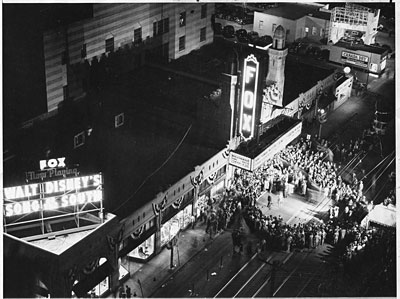

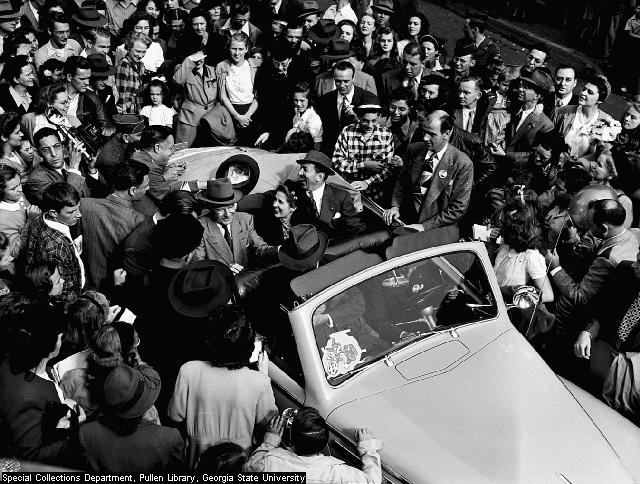
 On
November 12, 1946, the Fox hosted the World Premiere of what is most
likely the most important and controversial film the Fox ever had the
honor to premiere. The Atlanta Fox Theatre was chosen to host the
premiere of Walt Disney's "Song of the South"
that was being released by its partner, RKO studios (At that time,
Disney was not in the film distribution business and released its films
through RKO Studios). As it was in 1939 with Gone With the Wind,
a huge amount of fanfare was generated for this telling of the Uncle
Remus tales as told by Georgian native and Atlanta resident Joel
Chandler Harris in newpaper articles and books he had written he had
learned from former slaves during his youth.
On
November 12, 1946, the Fox hosted the World Premiere of what is most
likely the most important and controversial film the Fox ever had the
honor to premiere. The Atlanta Fox Theatre was chosen to host the
premiere of Walt Disney's "Song of the South"
that was being released by its partner, RKO studios (At that time,
Disney was not in the film distribution business and released its films
through RKO Studios). As it was in 1939 with Gone With the Wind,
a huge amount of fanfare was generated for this telling of the Uncle
Remus tales as told by Georgian native and Atlanta resident Joel
Chandler Harris in newpaper articles and books he had written he had
learned from former slaves during his youth. 
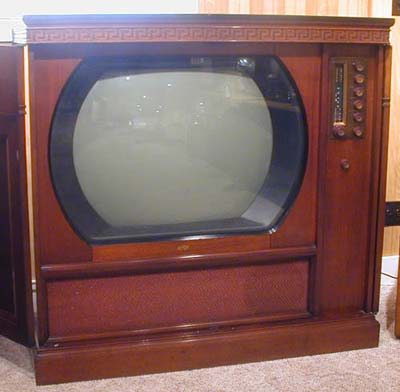 Television actually began broadcasting in the 1930s, prior to
the beginning of World War II. Because of the war, television took a back seat until after the war and it did not begin to
be accepted until the beginning of the 1950s. Compared to what
was to come, television sets were rather primitive and were massive
while the actual television screen was very small, usually under 12"
inches in diameter. They were housed in gigantic heavy wood cabinets and
if there was one thing they were not, they were not cheap!
Once mass production took hold, prices began to drop to a point where it became
affordable for the average home to buy a television set. For the longest time, it was big news
when a delivery truck arrived at a neighbor's door with their new TV
set.
Television actually began broadcasting in the 1930s, prior to
the beginning of World War II. Because of the war, television took a back seat until after the war and it did not begin to
be accepted until the beginning of the 1950s. Compared to what
was to come, television sets were rather primitive and were massive
while the actual television screen was very small, usually under 12"
inches in diameter. They were housed in gigantic heavy wood cabinets and
if there was one thing they were not, they were not cheap!
Once mass production took hold, prices began to drop to a point where it became
affordable for the average home to buy a television set. For the longest time, it was big news
when a delivery truck arrived at a neighbor's door with their new TV
set. 
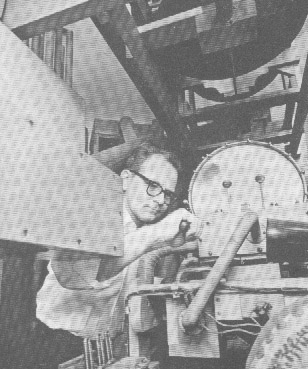 When the Fox was built, the M.P. Moller Company of Maryland built what
was the biggest theater organ in the world. It was also its last. It
was so massive, a
portion of a wall had to be knocked down in order to get the console
out of the factory. It was constantly played during most performances
once the Fox opened, but over time, problems developed with it playing
certain notes. Accomplished organists were able to play the "Mighty Mo"
by avoiding certain notes in certain keys, but by 1954, the Fox's
Moller organ had fallen into such disrepair, it could no longer be
played. In 1962, a man by the name of Joe Patten appeared at the Fox's
doorstep. A native of Florida, Joe had moved to Atlanta to work as an
engineer for Westinghouse. Two of his favorite past times were
automobiles and theater organs. Patten was an active member of the
Atlanta chapter of the American Theater Organ Society (ATOS), group
dedicated to the preservation of theater organs throughout the country.
When the Fox was built, the M.P. Moller Company of Maryland built what
was the biggest theater organ in the world. It was also its last. It
was so massive, a
portion of a wall had to be knocked down in order to get the console
out of the factory. It was constantly played during most performances
once the Fox opened, but over time, problems developed with it playing
certain notes. Accomplished organists were able to play the "Mighty Mo"
by avoiding certain notes in certain keys, but by 1954, the Fox's
Moller organ had fallen into such disrepair, it could no longer be
played. In 1962, a man by the name of Joe Patten appeared at the Fox's
doorstep. A native of Florida, Joe had moved to Atlanta to work as an
engineer for Westinghouse. Two of his favorite past times were
automobiles and theater organs. Patten was an active member of the
Atlanta chapter of the American Theater Organ Society (ATOS), group
dedicated to the preservation of theater organs throughout the country.
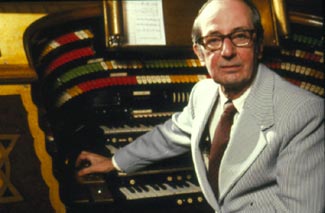 Bob Van Camp was a local Atlanta radio broadcaster that worked for WSB
(AM) radio. He was also a very accomplished organist. After more than
two decades of silence, Van Camp was to be the first to play the reborn
Mighty Mo. However on the scheduled date of it's premiere, Novermber
22, 1963, earlier in the day, President John F. Kennedy had been
assasinated. The concert was quickly cancelled in respect to the dead
president and rescheduled for the Thanksgiving weekened. When the
beautiful music poured out of the organ chambers as the Bob rode up
playing the console, people cheered!!! Bob became the regular organist
for the Fox and continued in that capacity until his death in the
1980s. Joe Patten continued his love affair relationship with the Fox
organ and remained a staple at the Fox, caring for the organ. A few
years after its restoration, Joe personally purchased a grand piano
that could be played remotely via the Moller console. At his expense it
was purchased, and removed from the Picadilly Theatre in Chicago. He
had it transported to Atlanta where he installed at the Fox and
integrated it into Moller organ system.
Bob Van Camp was a local Atlanta radio broadcaster that worked for WSB
(AM) radio. He was also a very accomplished organist. After more than
two decades of silence, Van Camp was to be the first to play the reborn
Mighty Mo. However on the scheduled date of it's premiere, Novermber
22, 1963, earlier in the day, President John F. Kennedy had been
assasinated. The concert was quickly cancelled in respect to the dead
president and rescheduled for the Thanksgiving weekened. When the
beautiful music poured out of the organ chambers as the Bob rode up
playing the console, people cheered!!! Bob became the regular organist
for the Fox and continued in that capacity until his death in the
1980s. Joe Patten continued his love affair relationship with the Fox
organ and remained a staple at the Fox, caring for the organ. A few
years after its restoration, Joe personally purchased a grand piano
that could be played remotely via the Moller console. At his expense it
was purchased, and removed from the Picadilly Theatre in Chicago. He
had it transported to Atlanta where he installed at the Fox and
integrated it into Moller organ system.